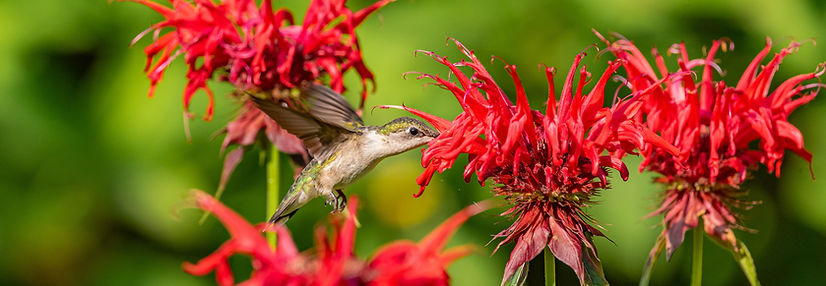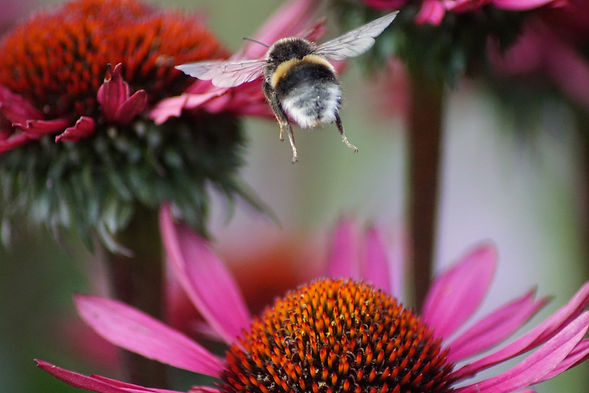
KEY PROBLEMS
Why are we concerned and need to take action?
There are many factors contributing to our concern for pollinators as well as for people. Most of the challenges for the health of pollinators also affect people and in fact, the potential decline of pollinators has direct consequences for human survival as well.
Let’s first start with - what are pollinators?
They are a broad set of species – mostly insects, but also birds, bats and other species – that are responsible for a great deal of plant reproduction. Many plant species require an external organism to move pollen from the male part of the plant to the female part to reproduce. This organism is often an insect that feeds on the pollen and, in the process, moves some of that pollen around, enabling the plant to reproduce.


The most well-known and iconic species that perform this service for plants are the honey bee and various butterflies, especially the monarch. However, there are thousands of native bees, many hundreds of species of butterflies and many other insects and birds that also do this both in our agricultural production and in our natural ecosystems. Honey bees are typically managed in hives by people and in the U.S., are an introduced species from Europe. The other species are typically less social and nest in various types of locations and are not usually managed by people. Often this distinction between their “lifestyles” is framed as managed pollinators that can be thought of as more similar to livestock versus native ones that are wild.
With that basic introduction, what are we worried about?
Biodiversity on our Planet
Biodiversity is key to healthy ecosystems on our planet. When we talk about biodiversity, we’re talking about having enough varied species of living beings: from the tiniest cellular organisms to insects to plants, birds, mammals and humans. We rely on this diversity to make a healthy and interconnected web of species. We need this diversity for ecosystem health as well human health, yet it is often threatened by multiple factors:
-
Monocultures – think about big green lawns with no flowers or big agricultural systems that have one crop covering thousands of acres and only blooms for a short period of time or in some cases not permitted to bloom at all. Read more about monocultures »
-
Habitat loss – when we develop areas for human habitation, agriculture or for large business needs, that habitat is not available for the species that used to live there. Food sources disappear and these species cannot find enough to eat.
-
Pesticide misuse, overuse and unnecessary use – when we eliminate species that we consider pests, we reduce biodiversity. This is tricky since insect pests or invasive weeds can negatively affect agriculture, yet when we use pesticides to address the issue, we may be eliminating desirable species as well. And those “bad” species are generally food for something out there as well. Pesticide overuse can apply to agricultural practices, to homeowner usage, or to public lands management.
-
Climate change – Our climate is changing. Temperatures are rising, ice caps are melting. These temperature changes impact available food sources for many pollinators and the ability of species to live in certain areas. For instance, if plants bloom earlier in the year due to warmer climates and insect pollinators have not yet emerged from their winter nests it leads to a mismatch in available ecological services.


All of these pressures on pollinator species can combine to have implications for their health. Pesticides can affect neurological functioning and their ability to navigate. Not enough food can make them weak and lessen their immune response. With respect to honeybees especially, pests such as varroa mites and the diseases they can carry are more likely to run rampant when immune systems are compromised and colonies are weak. All of these species might be able to withstand one of these pressures, but together, it is a critical time for their health.
How do we address this potentially devastating combination of challenges, in the context of our current society, to protect both pollinator and human health?

Our Food Production Systems
Our agricultural systems have changed a great deal in the past 50 plus years. Where we used to have a significant number of smaller family farms with crop diversity, we often have large-scale industrial agriculture. While this may be a more efficient way to farm, it isn’t necessarily best for the environment nor does is necessarily provide increased yields or healthier food.
Pesticide use has also increased dramatically. This includes insecticides, herbicides, fungicides and rodenticides. While pesticides are often considered essential to farming, the results can cause environmental damage.
A relatively new class of insecticides are the neonicotinoids. These are systemic pesticides that can cause an entire plant to have the pesticide within it – leaves, pollen, etc. While the pesticide is intended for certain species, it does not necessarily discriminate and increasingly, studies show that there are both direct and long-term unintended consequences for non-target species such as bees, butterflies and birds.
Herbicide use has increased, especially with the prevalence of GMO crops that are “roundup ready”. For example, more than 90% of corn grown in the US is genetically modified in this way. This allows farmers to eliminate weeds with broad spraying practices because the crops are not susceptible to the herbicide application. Unfortunately, some weeds are developing resistance and more critically, new scientific studies are showing that ingestion of herbicides can have a negative effect on pollinators as well.
Millions of acres in the U.S. are covered with crops that are planted with seeds coated with neonicotinoids. These seeds make the entire plant potentially poisonous. However, these coated seeds are not regulated by the E.P.A as a pesticide. This is true for corn, soybeans and many other large monoculture crop production. All of these crops are widely used in our food systems and for animal feed so the pesticides are an integral part of our human food intake.


Another big issue is the lack of scientific research on so called tank mixes. This applies to both agricultural applications where multiple chemicals are mixed together to make it more efficient to apply – for example, a tank mix with a fungicide, insecticide and herbicide all in one application. Chemical mixes are also widely available over the counter in home use products such as many all in one type yard care solutions. Most research is done on single chemicals, not on how these chemicals react when mixed together and create a synergistic result.
Our food production systems are dominated by industrial agriculture and the use of chemical pesticides and fertilizers and monocultures which many believe we cannot live without. We have also changed our overall ecosystems with various practices so that insect pests and invasive and noxious weeds can get out of control.
How do we find balance and pull back from these environmentally destructive practices while also maintaining food production?

A GOOD READ...
